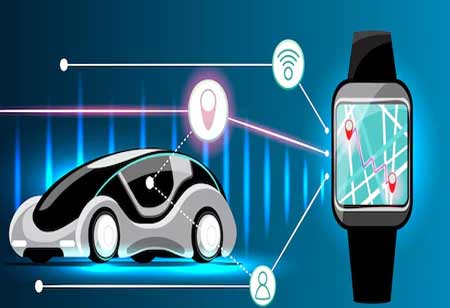THANK YOU FOR SUBSCRIBING
THANK YOU FOR SUBSCRIBING
Be first to read the latest tech news, Industry Leader's Insights, and CIO interviews of medium and large enterprises exclusively from Auto Tech Outlook

By
Auto Tech Outlook | Friday, July 04, 2025
Stay ahead of the industry with exclusive feature stories on the top companies, expert insights and the latest news delivered straight to your inbox. Subscribe today.
Efficient ride services are essential for organizations aiming to elevate customer satisfaction and streamline operations. By integrating AI into courtesy ride management systems, businesses in Canada have witnessed remarkable improvements, boosting operational efficiency, cutting costs, and significantly enhancing the overall customer experience. AI enables realtime route optimization, ensuring passengers arrive promptly while minimizing fuel consumption.
In major Canadian cities like Toronto, Vancouver, and Montreal, AI-powered systems can reduce the number of vehicles on the road through smart ride-sharing and fleet optimization. Using AI-driven analytics, operators can manage vehicle dispatch, anticipate peak demand, and reduce idle time, thus lowering carbon emissions. Furthermore, government policies and regulations are pivotal in adopting AI-driven ride management systems.
Canada is actively promoting innovative mobility solutions and sustainable transportation initiatives. Government incentives for integrating AI and more stringent emissions regulations encourage organizations to implement AI-powered ride management solutions. Moreover, the emergence of Mobility-as-a-Service (MaaS) platforms further reinforces AI-driven courtesy ride services by facilitating seamless connectivity among various transportation modes.
AI Implementation and Latest Trends
AI implementation in courtesy ride management involves a combination of machine learning, predictive analytics, and automation to enhance service efficiency. Many courtesy ride management systems now integrate AI-driven chatbots, allowing passengers to book rides, check estimated arrival times, and receive real-time updates. Predictive maintenance is also transforming fleet management. AI-powered systems monitor vehicle health in real-time, identifying potential mechanical issues before they become critical.
Operators can reduce downtime, extend vehicle lifespan, and lower maintenance costs by predicting maintenance needs. This proactive approach ensures that courtesy ride services remain reliable and efficient. Integrating AI with IOT technology is another major trend. IoT vehicle sensors provide real-time data on vehicle performance, fuel efficiency, and passenger load. AI algorithms analyze this data to optimize fleet operations, reduce fuel consumption, and improve efficiency. AI-driven safety systems detect potential hazards and assist drivers in avoiding accidents, enhancing passenger safety.
Smart Rides, Seamless Solutions
AI-powered courtesy ride management systems have a wide range of applications across various industries in Canada. In the hospitality sector, hotels and resorts use AI-driven ride services to transport guests to and from airports, train stations, and local attractions. AI optimizes shuttle schedules based on real-time demand, ensuring minimal wait times for guests. Hospitals and medical facilities rely on AI-powered courtesy ride services in the healthcare industry to transport patients, especially those with mobility challenges.
AI-driven scheduling systems ensure that rides are available when needed, reducing missed medical appointments and enhancing patient care. AI optimizes vehicle dispatching to accommodate multiple patients efficiently, lowering healthcare providers' costs. Corporate and public transit sectors benefit from AI-powered ride management. Many companies offer shuttle services for employees, and AI optimizes these services by analyzing commuting patterns and demand trends. Public transportation authorities use AIdriven courtesy ride solutions to enhance first-mile and lastmile connectivity, improving commuter accessibility.
AI-powered courtesy ride management faces several challenges. AI systems rely on vast passenger data, including location tracking and travel preferences. Ensuring data protection and compliance with Canada's privacy laws is critical. Implementing robust encryption and anonymization techniques can mitigate these concerns. Many organizations still use traditional scheduling and dispatching software, making AI adoption complex. AI reliability and bias are significant concerns in ride management systems. Regular audits and continuous model training can improve AI accuracy and eliminate potential biases in ride allocation and route optimization.
AI-Driven Rides: Transforming Canada's Transit Future
The adoption of AI-powered courtesy ride management is transforming the transportation sector in Canada. Businesses and service providers that leverage AI-driven solutions are experiencing reduced operational costs, improved efficiency, and enhanced customer satisfaction. By minimizing idle time, optimizing fleet operations, and automating customer interactions, AI-powered systems contribute to higher profitability and service quality.
AI-driven ride management also supports Canada's sustainability goals. By reducing unnecessary vehicle trips and improving fuel efficiency, AI-powered systems contribute to lower carbon emissions and improve urban mobility. The future of AI-powered courtesy ride management in Canada looks promising, with advancements in autonomous vehicle technology and AI-driven intelligent transportation networks. Integrating self-driving shuttles into courtesy ride services could enhance efficiency and reduce operational costs.
AI is essential for building smart city infrastructure, integrating ride management systems with public transportation, EV charging stations, and real-time traffic management solutions for a more efficient urban experience. AI-powered courtesy ride management is revolutionizing transportation in Canada by improving efficiency, reducing costs, and enhancing customer experiences. While challenges such as data security, AI bias, and system integration exist, continuous technological advancements and regulatory support will drive further innovation.
 Copyright © 2025 AutoTech Outlook. All Rights Reserved | Privacy Policy | Subscribe | Sitemap | About us | Feedback Policy | Editorial Policy
Copyright © 2025 AutoTech Outlook. All Rights Reserved | Privacy Policy | Subscribe | Sitemap | About us | Feedback Policy | Editorial Policy 



